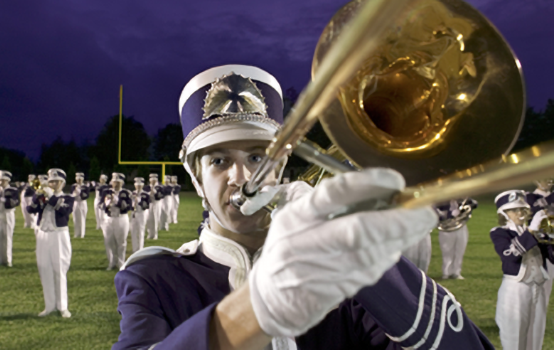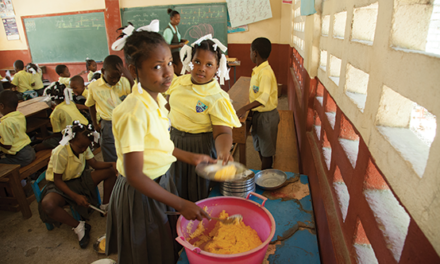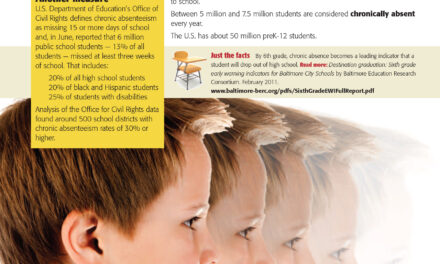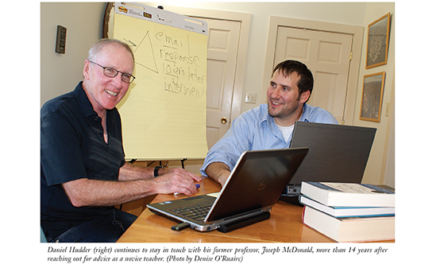
Playing on a school sports team prepares youth for engaging in civic life,
but students gain as much — and maybe more — from joining other extracurricular activities at school.
Evidence suggests that high school sports make students into active citizens. One study found that former high school athletes were more likely than their peers to volunteer regularly as young adults, vote, feel comfortable making statements in public, and watch the news (Lopez & Moore, 2006).
A positive link between sports and civic engagement would be important because schools have a civic mission, and virtually all schools offer sports. Indeed, universal education was invented in the United States to prepare citizens for the substantial obligations of citizenship, such as voting wisely, serving on juries, and running the associations that compose civil society.
Promoting sports as preparation for civic life has a long tradition. W. Martin Bloomer wrote that the classical Greeks “believed that practicing sports contributed not only to excellence in the events themselves but also to excellence in areas which demanded characteristics that were akin to those fostered by athletic training,” which included public speaking (2015, p. 434). The Duke of Wellington is supposed to have said (although the quotation is probably apocryphal) that the battle of Waterloo was won on the playing fields of Eton. That phrase became proverbial because Victorians believed that sports taught discipline, teamwork, and strategy.
Correlation does not prove causation. Perhaps sports participation and civic engagement reflect other factors such as an energetic and outgoing personality, better schools, or more supportive families. In that case, encouraging more sports participation would not boost civic engagement because it wouldn’t change the underlying factors that explain both. However, Lopez and Moore used statistical techniques to check for such explanations, and their work suggests that athletics increases civic engagement.
Athletic success requires training and preparation before a high-stakes public performance; the same is true of many forms of civic participation.
An explanation for this link could derive from how athletic competition teaches specific values and skills useful to citizens. For instance, athletes compete on teams, and active citizens address public problems collaboratively. Perhaps sports teamwork teaches civic teamwork. Also, athletes learn to lose and play again another time. Similarly, any active citizen sooner or later will support a losing candidate or cause. Good citizens bounce back and participate the next time anyway.
Athletic success requires training and preparation before a high-stakes public performance. The same is true of many forms of civic participation. For example, a citizen may have to prepare to speak well in a public meeting. Finally, civic participation, like athletic competition, works best when it is structured by fair rules, which good players — like good citizens — learn to honor and appreciate. At the same time, they can learn to challenge and change bad rules.
These are reasons to predict that sports would be especially good preparation for civic life. But the pattern is more complicated. Nearly all forms of extracurricular participation in high school raise the participants’ civic engagement later in life — whether a group is explicitly civic (student government or a service club) or far removed from civic life (an academic club or a music group). But in some studies, sports emerge as an unfortunate exception to this pattern (Verba, Schlozman, & Brady, 1995; Thomas & McFarland, 2010). If almost all extracurricular participation enhances civic engagement, then perhaps it’s not athletic competition but belonging to groups that makes people into active citizens.
Differences
In fact, we should consider some important differences between scholastic team sports and civic life. Not all forms of civic engagement are competitive. Nobody loses when a group of citizens clean up a local park. In civic life, you are not necessarily assigned a team but may choose a position and group that reflects your values. Sometimes civic engagement is not about the individuals gathered for the task but about something else. Juries, for example, may decide whether to take the life of a person accused of a capital crime. In that case and many others, civic engagement is a lot more serious than sports.
Then again, no one has argued that sports equal civic engagement or that the playing fields of Eton were exactly the same as the battlefield of Waterloo. The claim is that there is enough similarity that sports can help to educate for citizenship (Fullinwider, 2006).
If almost all extracurricular participation enhances civic engagement, then perhaps it’s not athletic competition but belonging to groups that makes people into active citizens.
No doubt, some students learn civic skills and values from sports. But the important pattern is that they learn those skills from student groups in general. Belonging to groups may build confidence, and participation may be sufficiently satisfying that members develop a taste for engaging with other people. Students may form networks in school groups that keep them connected to associations as they age. Adolescents in particular may form respectful and supportive relationships with adults other than their own parents, and those adults may model and encourage civic engagement. For example, the high school theatrical director, band leader, or lacrosse coach may vote and may talk with students about voting.
Developing initiative
School groups also help students develop initiative. According to Reed Larson, students learn initiative by participating in voluntary, purposeful, collective activities such as publishing a school newspaper, organizing a dance, or fielding a soccer team. Larson defines “initiative” so that it involves a long-term arc: A person with initiative forms a plan, takes action, adjusts the plan, and acts again. Most academic assignments do not involve initiative because they require discreet tasks, such as writing an essay or taking an exam. Pure, unstructured play also fails to teach initiative because it is episodic, but extracurricular groups almost always involve long arcs of intentional activity (Larson, 2000).
Further, as the Nobel Prize winner Elinor Ostrom found in her whole body of work, citizens must learn to overcome the problems that beset all collective human enterprises, such as how to recruit new members, how to deal with slackers, and how to handle disagreements. Extracurricular participation can teach the concrete skills needed to make groups work, including how to respond when some members shirk their duties, how to keep records and chair meetings, how to handle a budget, how to persuade groups of peers, and how to advertise the benefits of an association to outsiders. Once these skills are learned, they enhance that person’s ability to participate in civil society.
Thus, recruiting students into satisfying extracurricular activities may help make them good citizens. Presented with this argument at a meeting of the Campaign for the Civic Mission of Schools, U.S. Supreme Court Justice Sandra Day O’Connor recalled that she had been a shy high school student until she joined a school group. She was then on a path to become an attorney, an influential state legislator, and the first woman to be on the U.S. Supreme Court.
Unfortunately, the most common types of groups (athletics, cheerleading, music, drama, debate, newspaper, yearbook, student government, subject matter clubs, and vocational clubs) all shrank between 1991 and 2011, attracting smaller proportions of young people. The proportion of students who participated in school-based athletic clubs fell five points during that period, to 44.1%. School newspapers, yearbooks, and other publications shrank 3.5 points to 13.4%, and student governments fell two points to 16% during the same two decades. The only significant increase was volunteer service. Time spent on athletics and physical exercise (including outside of school) has increased since 1991, although it hasn’t returned to the level recorded in 1981.
Since extracurricular groups are too small and too poorly supported to reach all students, participation is badly unequal. My colleague Kei Kawashima-Ginsberg analyzed national data on high school students collected by the Monitoring the Future survey. She used cluster analysis, a technique often employed by advertisers to categorize audiences, and found that American high school students fell into six clusters (Kawashima-Ginsberg, 2014). I will focus on three of the groups because comparing them tells a valuable story about sports.
Athletes, leaders, and invisibles
In her terminology, about one-quarter of students are “athletes.” They are all involved in organized sports but usually not involved in other extracurricular groups. They tend to be social and report being happy in life. Their academic performance is average, and they are prone to risky behaviors. We do not know whether they will turn into engaged citizens, but there is some reason to be concerned because they do not show a lot of interest in the explicitly civic groups in their schools. Again, the evidence that athletics alone boosts civic engagement is mixed.
Another noteworthy group of 11.4% are “leaders.” They participate in student government and volunteering and community organizations and average 4.4 concurrent school activities. They are reasonably social and have solid self-esteem, and their academic performance is high. Some are athletes, certainly, but they have a broader portfolio of interests. The prognosis for their future civic engagement is very good, but they represent only one in nine of our youth.
A third group that is important to contrast with the former are the “invisibles.” Representing almost 19% of young people, they are defined by not participating in school-sponsored clubs or social activities outside of school. They report low self-esteem and low academic performance and are most likely to say that they are “often bored.” Again, we do not know what will happen to them later, but there is a grave risk that they will be left out of civic life.
These groups are sociologically very different from each other. “Leaders” are more affluent as well as more female than other clusters; “invisibles” are poorer and come from families with lower educational success. We know from other research that upper-income families are increasingly paying for extracurricular activities in the private sector, just as support for free activities inside schools is shrinking. The result is a growing class gap in participation that will likely reinforce the deep class gap in political participation.
The case for groups
If we treat a school’s collection of clubs as a microcosm of civil society, then some propositions about the adult nonprofit sector ought to apply. It is desirable for as many people as possible to be in groups of one kind or another, but activities require support. Student groups and extracurricular activities need more funding and staff time so that lower-income students can participate fully.
Pluralism and choice are valuable; people cannot be herded into groups that others may consider valuable. Even more than adults, adolescents must be free to experiment in order to develop their interests and identities. Sports are among the groups that should be offered. They appeal to some students who may not want to join other activities, including clubs with explicit missions of service or political leadership.
A major underlying reason that we want students in groups is that they can learn values and skills useful for solving problems that confront all voluntary associations in a free society. Thus, students should be allowed, supported, and obliged to address challenges on their own. For instance, if recruiting enough players for the cross-country team or dealing with late or absent players emerge as challenges, then students themselves should be primarily responsible for choosing and implementing solutions. If the adult coach handles all problems, players are less likely to learn civic skills. Indeed, I would posit that we see more consistent, positive civic effects from other groups than from team sports because too often adult coaches dominate teams.
Finally, we benefit when civil society cultivates what Harvard political scientist Robert Putnam, author of Bowling Alone, calls “bridging social capital.” That is, people ought to learn to work together in diverse groups and develop trust and networks that bridge differences; they should not merely use associational membership to differentiate in-groups from out-groups. All sports teams harbor some diversity, but they can be relatively homogeneous enclaves within schools. The solution is not to force all students into diverse groups but to try to lower the barriers between homogenous in-groups.
In Democracy and Education, Dewey recognized that “in any social group whatever, even in a gang of thieves, we find some interest held in common, and we find a certain amount of interaction and cooperative intercourse with other groups. From these two traits we derive our standard. How numerous and varied are the interests which are consciously shared? How full and free is the interplay with other forms of association?” (Dewey, 1916, p. 89). Applying those criteria to sports teams in modern schools, we should ask players to hold several goals in common (not only victory but also the diverse needs of the members). We should encourage teammates to participate in other associations beyond the team. We should be concerned when one goal dominates or when teams wall themselves off from the rest of the civil society of the school.
I have argued that extracurricular activities enhance democracy. Sports teams contribute to that end, although the evidence is somewhat mixed, and they should be structured a bit more like typical student clubs — with lower barriers to entry and more student responsibility for solving problems.
Because sports teams and other forms of extracurricular activity are shrinking and miss a substantial proportion of our youth entirely, they need explicit advocacy. Some adult groups support and defend student groups that specifically interest them, whether that means boys’ football, Bible clubs, or Gay-Straight Alliances. Civil libertarians defend students’ general legal rights to associate. But nobody is organized to say that there should be adequate funding, support, space, and time for a whole range of voluntary associations in all of our schools. That cause is important for the future of American democracy.
References
Bloomer, W.M. (2015). A companion to ancient education. Hoboken, NJ: John Wiley & Sons.
Dewey, J. (1916). Democracy and education, New York, NY: MacMillan.
Fullinwider, R.K. (2006). Sports, youth, and character: A critical survey (CIRCLE Working Paper No. 44). Medford, MA: Center for Information and Research on Civic Learning and Engagement. http://bit.ly/1RA9ud4
Kawashima-Ginsberg, K. (2014). Harry, Hermione, Ron, and Neville: Portraits of American teenagers’ extracurricular involvement, and implications for educational interventions (CIRCLE Working Paper No. 80). Medford, MA: Center for Information and Research on Civic Learning and Engagement. http://bit.ly/1Uf3Hy7
Larson, R.W. (2000, January). Toward a psychology of positive youth development. American Psychologist, 55 (1), 170-183.
Lopez, M.H. & Moore, K., (2006, February). Sports and civic engagement (CIRCLE Fact Sheet). Medford, MA: Center for Information and Research on Civic Learning and Engagement. http://bit.ly/1M6SOrP
Thomas, R.J. & McFarland, D.A. (2010). Joining young, voting young: The effects of youth voluntary associations on early adult voting (CIRCLE Working Paper No. 73). Medford, MA: Center for Information and Research on Civic Learning and Engagement. http://bit.ly/1R78EUA
Verba, S., Schlozman, K.L., & Brady, H.E. (1995). Voice and equality: Civic voluntarism in American politics. Cambridge, MA: Harvard University Press.
Citation: Levine, P. (2016). Join a club! Or a team — both can make good citizens. Phi Delta Kappan, 97 (8), 24-27.
ABOUT THE AUTHOR

Peter Levine
PETER LEVINE is associate dean for research and Lincoln Filene Professor of Citizenship and Public Affairs at Tufts University’s Jonathan Tisch College of Citizenship and Public Service, Medford, Mass. He has a secondary appointment in the Tufts philosophy department.










